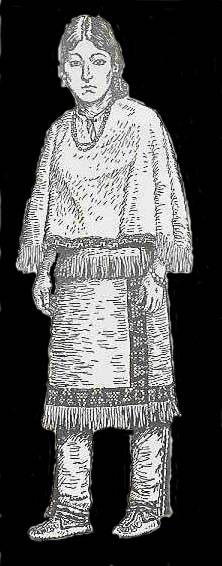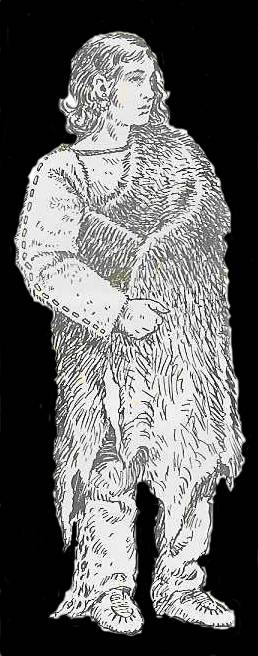

At the time of the arrival of the Europeans to the New World, the physical appearance of the Lėnape people was very similar to that of the Europeans. The average height of the Lėnape male ranged from 5'7" to 5'10", although exceptions were commonplace. (Taller than the average European) Both the Europeans and the Lėnape have oval-shaped faces (dolicocephalic), but the Lėnape had dark eyes (brown or black) and slightly more prominent cheekbones. The Lėnape skin color ranged from a light tan (similar to southern Europeans)to a very dark, almost black, complexion. Facial hair was rare, as the Lėnape thought it unmanly to grow mustaches or beards, and so it was kept shaven or plucked. It is interesting to note that the earliest European explorers were so amazed at the similarity in appearance of the "natives" to themselves that they wrote extensively about it in their journals.
In 1683, William Penn wrote his now famous accounts of the Lėnape people. In these accounts he describes their physical appearance as rather European looking, in fact he compares them to Italians in overall appearance. Penn wrote the following description: "For their Persons, they are generally tall, streight, well-built, and of singular Proportion; they tread strong and clever, and mostly walk with a lofty Chin: of Complexion, Black, but by design, as the Gypsies in England: They grease themselves with Bears-fat clarified, and using no defence against Sun or Weather, their skins must needs be swarthy; Their Eye is little and black, not unlike a straight-look't Jew. The thick lip and flat Nose, so frequent with the East-Indians and Blacks, are not common to them; for I have seen as comely European-like faces among them of both, as on your side of the sea; and truely an Italian Complexion hath not much more of the White, and the Noses of several of them have as much of the Roman."
The Lėnape people wore clothing made of leather, fur, and feathers. Deer was the primary material used in making clothes, but elk, bear, and other animal hides were used as well. Beadwork and porcupine quillwork were used extensively to decorate the clothing and accessories, and embroidery was also used as well. Embroidery was done by the use of dyed sinew or thin leather strips as thread.
Nearly all items of clothing had some extent of fringe built into it, the extent of the fringe was dependent on the particular article. Fringe was not a decorative touch to clothing, it served an important function. Fringe serves as a series of wicks which draw moisture from the article and drips that moisture off. Fringe, was in fact a sort of clothes dryer.
In the summer and warm months the men wore leggings and breachcloth. The women wore a skirt that was a long rectangular piece of leather which wrapped around the body and fastened close. The women also went without covering the upper body except as weather may dictate. Wide belts were worn by both sexes which were generally beaded.
During the winter and cold months, the men would wear a robe made of bear hide wrapped around their bodies, leaving one arm exposed. A fur sleeve, most commonly made of either otter or beaver skin, was worn on the exposed arm. The women would wear a rectagular cape over their upper bodies, and also wear a fur robe. A second style of robe worn by both sexes was made of turkey feathers attached to a leather base.
Although shirts were not unknown to the Lėnape, and were worn on occasion, they were not a regular piece of attire. The style of shirt most common to the Lėnape extended to about mid-thigh. The belt described elsewhere in this section is worn on top of the shirt.
Lėnape style moccasins were made of one piece of leather with a single seam along the center line of the top of the moccasin and a shorter seam up the back (the heal). They had a cuff along the top which folded down, looking sort of like the collar of a shirt. A small, fringed tab extended from the bottom of the heal. This tab served as a drying mechanism. The center seam and cuffs were often decorated with either beadwork or quillwork.
Pouches were worn by both sexes which hung at the side by means of a shoulder strap. The straps were fully beaded and the pouches decorated to varying degrees. These pouches were used to carry the individual's personal items. Medicine bags were worn around the neck and were often decorated with the symbol of the person's guardian animal spirit. Chiefs wore a headdress of feathers. This headdress is NOT like the Lakota bonnet which is so familiar to all - it is simply a headband of turkey feathers which stand straight up. Another style of "headdress" worn was a "roach" decorated with dyed deer hair and turkey beards. The roach was worn by many of the warriors and young men. The Lėnape rarely wore feathers in their hair, or in their roaches, although the addition of a feather or two to a roach was done on rare occasions. The only time the exception to wear feathers was made was by warriors when at war.
The men wore their knives suspended from their neck, not hung at their sides from a belt. Also worn suspended from their necks was a pouch which held their supply of tobacco and personal smoking pipe.


Jewelry was popular and worn by both sexes. Necklaces, bracelets, hair pieces, and earrings were the most common items worn. Jewelry items were made of bone, shell, and beads. Tattoos were common among both sexes, and tattoos were placed throughout the body.
The ila (warriors) and skinu (young men) wore their hair in what has become known as the "Mohawk". It should be noted here that this hair style was NOT an Iroquoian style at all, but rather, an Algonkian hair style. Another popular hair style among the ila and skinu was to shave the head except for a long scalp lock at the back of the head which was left to grow quite long and then braided or tied into what looks similar to a "pony tail". (Somewhat similar to the Cossacks). The older men and elders wore their hair long and braided. The women wore their hair long and braided.




There is no drum accompaniment to this dance, but the leader carries a rattle and he is the main singer. The men usually sing along with him.
The dance begins with the men, lined up in single file, moving with a shuffle step. Eventually the women join in, lining up in any free space between the men.